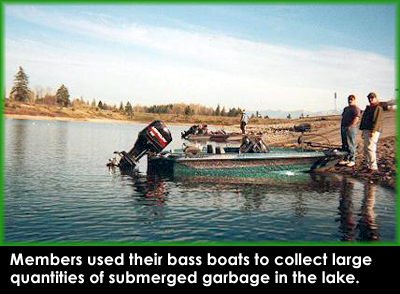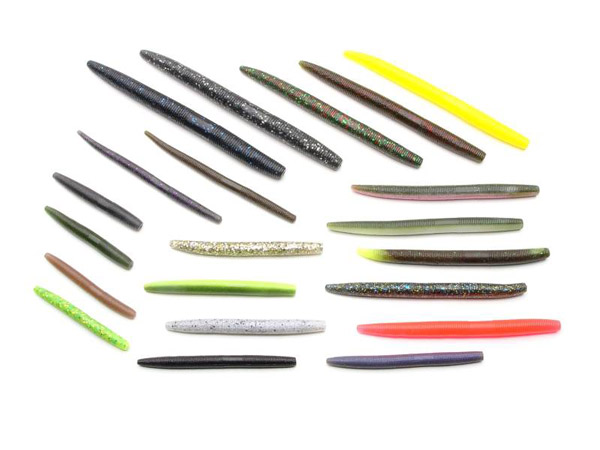| Home Page
About Page
Photo Page
What's New Page
Contact Page
Favorite Links
Custom Page
Guest Book Page
|
|
|
THIS PAGE IS UNDER CONSTRUCTION!!!!!
All the writing on this page is default writing. In the very near future, this page will provide additional information on bass fishing in British Columbia.
|
 The WCBA helping the environment!
The WCBA helping the environment!
Members of the WCBA are dedicated to keeping our local lakes beautiful. |
|
Bass Fishing Throughout the Year
In Winter, we all know bass become dormant and sluggish. British Columbia has long winters so this phase lasts longer here than most places. Bass will be in their near hibernatic(i made up that word) state from mid-November to Early-March on Vancouver Island, the Okanagan and the Lower Mainland, and from early November to early April in the Kootenays. Despite this, Duck Lake is famous for its ice fishing for bass, strange because of how shallow it is. I haven't heard much about ice fishing in other lakes so I don't really know how they would be. Spring is an exciting time for bass fishing. In April, bass move into the shallowest part of the lake to take in as much of the sun as possible. They are very spooky at this time and therefore quite difficult to catch. Try to approach them as stealthy as possible and cast well past the fish. Use small or weightless lures so as not to spook any with the cast. I have found white to be the best colour at this time. Try crawling a lure along the bottom towards the fish, but not too close, do this to test if the fish is interested in the hook or not. If this doesn't work try a plastic jerkbait or floating rapala and twitch it by the bass. If nothing seems to work its best to just move on. The next part of the year is the spawning season, May to June. Female bass move into shallow water (1-6 feet deep) and build nests (2-5 feet across). At this time they can be very prone to being caught as they are very protective of their nests and any lure that looks to threaten the nest will be attacked. Many ethical anglers choose not to fish at these times, but it is your best chance of hooking a trophy bass all year. After the females spawn, the males remain behind to protect the nest and the females move to deeper water. You can try to catch these males on the nest but keep in mind, the bigger females are usually less than 20 feet from the nest. After the spawning season, females are tired from spawning and males from guarding the nests. In lakes with healthy carp populations, male bass become horribly scarred from ramming the carp which approach the nest all spring. For the next few weeks big bass are tired and hard to catch, fishing for smaller bass can be great though. The next season is the summer months. Summer bass fishing can be excellent and terrible. When the weather gets hot, bass can be quite difficult to catch in midday, but morning and evening time can be phenomenal. Cloudy, calm days can also create awesome fishing conditions as bass move into the shallows to feed. Remember that bass are light sensitive and like to avoid direct sunlight. Midday bass will either search out shade and heavy cover, or move to deeper water. During summer nights try topwater fishing for some excitement. Then comes fall. In mid-september, with fall turnover approaching, bass fishing can be spectacular all day long. They will readily hit surface lures and spinnerbaits, as they feed aggressively to put on some weight before winter. This feeding spree lasts until mid october or early november.
|
|
Getting There
Use this template for any additional information you need such as products, pictures, fan clubs, links or just more information It's important to regularly change the content on your site and make updates to the information that you display. Doing this will help you to get more return visitors.
Add your link here
BC Bass Forage
The main food source for bass in BC, changes lake by lake. In the East Kootenays, the major bass food is Pumpkinseed Sunfish and squawfish, as well as Yellow Perch, shiners, and on a smaller scale trout. Bass will also readily attack large insects like dragonflies, dragonfly nymphs, water boatmen, stoneflies, hellagrammites, and caddis larva. Other water dwellers like leeches, worms, lizards+salamanders, and crayfish are popular forage in all lakes. In the south Okanagan however, bass prefer more streamlined forage such as minnows, squawfish, and trout. Juvenile crappie are also popular food in Osoyoos Lake and the Lower Mainland. Bullhead, and baby catfish are other food fish for bass. Largemouth Bass, due to their aggressive nature, will also readily attack frogs, toads, mice, snakes, and even baby ducks when in the mood. Crayfish are a favourite food of the Smallmouth Bass, as are minnows, leeches and other aquatic insects. Largemouth bass will more readily attack surface lures, however Smallmouth have been known to take crankbaits and poppers when they are floating on top.
Add your link here
|
 Senkos!
Senkos!
A variety of senkos. If you ever see any anywhere, buy 'em, you wont be disappointed. Check out www.baits.com for more. |
Release 'em Unless They're For Eatin'
Bass have become somewhat of a problem in the Lower Mainland of British Columbia so please don't transport live fish unless you've purchased them and they're destined for the aquarium. Bass have established populations in Fishtrap Creek, Walmsley Lake, Marshes and Sloughs around Pitt Lake, Boundary Lake, Gloucester Ponds, and Hatzic Lake. Any bass caught in other systems should be reported to the DFO. Report all other alien fish as well. |
|
|


